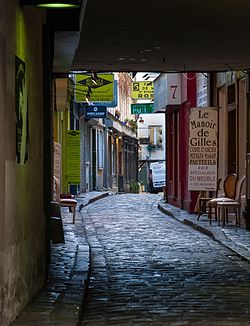Faubourg Saint-Antoine
| Faubourg Saint-Antoine | |
|---|---|
| Faubourg | |

Passage du Chantier
|
|
 Vaugondy's map of Paris (Faubourg Saint-Antoine) - 1760 |
|
| Location in Paris | |
| Coordinates: 48°51′02″N 2°22′45″E / 48.8505°N 2.3792°ECoordinates: 48°51′02″N 2°22′45″E / 48.8505°N 2.3792°E | |
| Country | France |
| City | Paris |
| Arrondissement | 12th |
The Faubourg Saint-Antoine was one of the traditional suburbs of Paris, France. It grew up to the east of the Bastille around the abbey of Saint-Antoine-des-Champs, and ran along the Rue du Faubourg Saint-Antoine.
The Faubourg Saint-Antoine extended from the Porte Saint-Antoine towards the abbey of Saint-Antoine-des-Champs, then to the Château de Vincennes. Roads led to the villages of Charenton, Charonne, Reuilly and Montreuil, which provided large amounts of wine, fruit and vegetables to the city. Today the former faubourg is divided by the rue du Faubourg Saint-Antoine between the 11th arrondissement of Paris, which extends to the north of the road, and 12th arrondissement, which extends to the south.
The suburb was the location of the Battle of the Faubourg St Antoine on 2 July 1652.
In the 17th century, according to Piganiol de La Force, "The Faubourg Saint-Antoine increased prodigiously from the large number of houses that were built there, both because of the good air and because of the king's letters patent of 1657, which exempted from the qualification of mastership all artisans and tradespeople who lived there." Firewood and construction timber from higher up the Seine was unloaded at the nearby Quai de la Rapée on the Île Louviers and stored in the faubourg, leading to development of woodworking crafts.
Skilled Flemish and German artisans, often Protestant, moved to the faubourg and worked as carvers, gilders, polishers, turners and cabinetmakers. Jean-Baptiste Colbert established the royal mirror factory on the rue de Reuilly. The factory of Jean-Baptiste Réveillon on the rue de Montreuil on part of the site of the former Folie Titon became the royal wallpaper factory under Louis XVI of France. In April 1789 the contractor running the Réveillon factory sparked a riot by threatening to cut wages. The factory was badly damaged, troops were brought in and several dozen people were killed.
...
Wikipedia

